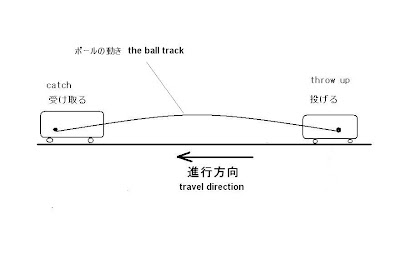兄ちゃんの思い出
まだ兄も私も小学生だった頃、駒野駅(母の実家の最寄り駅)に行く電車の中で科学の実験をしたことがあります。僕達は電車のベンチ式座席に並んで座っていました。
気がつくと、兄は何度もボールを放り投げては受け止めているのです。受け止める度に、頭をかしげ、何か疑問に思っているようでした。兄は、わたしにボールを放りあげさせ、わたしの手とボールの動きをじっと観察しました。兄はわたしに、「ボールを捕るとき絶対に手を横にずらしてはいけない」と言うんです。わたしは何やってるんだろうと思いました。兄曰く、「どうしてボールが手に落ちてくるんだろ。いいかい、ボールが空中に飛んでいる間、電車は走ってるんだ。だから、ボールは手に落ちなくて、後ろの方に落ちるはずだ。でも、後ろには落ちない。おかしいなぁ」わたしはやっと兄の疑問が分かりました。兄はわたしからボールを取り、またできるだけ高く、電車の天井に届くぐらい、放りあげました。空中に飛んでいる時間を最大限伸ばすためです。でも、何度やっても、ボールはちゃんと手に落ちてくるんです。
僕たちの向かい側に座っている人達は、面白がって僕達を見ていました。僕達が単にボール遊びをしているんだ、と思っていたかも知れません。でも、僕達が、不思議だ、どうしてだろう、と言っているやり取りを聞いたはずです。なのに、誰も「坊やたち、何してるんだい」と聞いてくる人はいません。多分、この物理現象を僕達に分かりやすく説明する自信がなかったのでしょう。
さて、高校で物理を習った者として、この二人の豆科学者に私から説明してみようと思いますが、うまく行きますか。
私は椅子から立ち上がり、兄弟のところへ行き、「君達、おかしいなぁと思ってるんだね。ボールがどうして後ろに落ちてこないか不思議に思ってるんだろ。じゃあ、おじさんが説明してあげよう。まずね、坊やが手に持っているボールは、電車と同じスピードで、電車と一緒に前へ動いているんだよ。このこと分かるね。だから、ボールが空中に放りあげられると、上だけじゃなくて、電車が走っている方向にも飛んでるんだ。で、田んぼで、この電車を見ている人がいるとするね。坊やがボールを放りあげると、その人からは、ボールが真上に上って、真下に落ちてくるようには見えないんだ。実際に見えるのは、ボールが電車の中で曲線を描いて飛んでいるいるように見えるんだ」
うーむ、説明が難しい。これで坊やたちは分かっただろうか。ちゃんと図解して説明してやった方がいいだろうなぁ。
子供だったとき、兄とトランプ、双六、将棋、相撲、コマ回し、凧揚げ、割り箸鉄砲などでよく遊びました。一番面白かったのは割り箸鉄砲です。割り箸3個とゴム輪があれば鉄砲を作ることができます。まず、割り箸を割って、3センチぐらいの引き金を二本の箸の間に挟み、ゴム輪で固定します。6センチほどの箸を二本三角形に組んで、握りをつけ、輪ゴムで固定します。これで出来上がりです。ゴム輪の一方を銃口にかけ、引き伸ばして他方を引き金にかけます。引き金を引くと、ゴム輪は2,3メートル飛びます。マッチ箱を2メートル先に立てて、狙いを定めて引き金を引けば、名射手なら、マッチを倒すことができます。マッチを倒した者は、マッチの周りに落ちている当たらなかったゴム輪を獲得できるのです。
MEMOIR OF MY BROTHER
One summer day when we were elementary school boys, my brother, Tadakazu, and I had a scientific experiment during the train ride to Komano Station (the nearest railway station from our mother’s parents’ home). We were sitting on a bench seat side by side.
Before I knew it, I found my brother repeatedly throwing up and catching a ball in the train. He tilted his head every time he tossed and caught the ball. He looked puzzled. He then let me do the same action again and again looking at my hand and the ball simultaneously. He was making sure that I did not move my hand sideways even an inch the moment I caught it. I wondered what he was doing. He said, “I don’t understand why the ball drops in your hand. You see, while the ball is in the air, the train is moving fast. So it must fall on somewhere behind instead of your hand, but it doesn’t. Isn’t it strange?” I understood what he was wondering about. My brother took the ball from me and threw it as high as possible, almost touching the ceiling of the train so that the ball had plenty of time to stay in the air. But try as he might, the ball dropped exactly in his hand.
The passengers sitting opposite us were curiously looking at us. Some of them might have thought that we were just playing with the ball, but obviously they must have heard our puzzled conversation. However, no passengers dared to interrupt us to ask what we were doing. Maybe they did not have confidence to explain the physical phenomenon easily enough for us to understand.
Now as an adult who has studied physics in high school, I hope I can explain the phenomenon in an understandable way for the scientific-minded boys. Before I knew it, I found my brother repeatedly throwing up and catching a ball in the train. He tilted his head every time he tossed and caught the ball. He looked puzzled. He then let me do the same action again and again looking at my hand and the ball simultaneously. He was making sure that I did not move my hand sideways even an inch the moment I caught it. I wondered what he was doing. He said, “I don’t understand why the ball drops in your hand. You see, while the ball is in the air, the train is moving fast. So it must fall on somewhere behind instead of your hand, but it doesn’t. Isn’t it strange?” I understood what he was wondering about. My brother took the ball from me and threw it as high as possible, almost touching the ceiling of the train so that the ball had plenty of time to stay in the air. But try as he might, the ball dropped exactly in his hand.
The passengers sitting opposite us were curiously looking at us. Some of them might have thought that we were just playing with the ball, but obviously they must have heard our puzzled conversation. However, no passengers dared to interrupt us to ask what we were doing. Maybe they did not have confidence to explain the physical phenomenon easily enough for us to understand.
I would stand up from my seat, approach the brothers, and say to them, “Hi, boys, I know what you are puzzled about. You want to know why the ball doesn’t fall behind, don’t you? Let me explain. First, you must recognize that while you are holding the ball in your hand, it is moving as fast as the train. Therefore, when you throw it up in the air, it moves not only upward but also forward in the direction the train travels. Suppose a man is standing on the rice field looking at the train. When you throw up the ball, he does not see it go up and come down vertically. Instead, he sees it flying in an arc.”
Well, it is difficuI to explain the phenomenon to them. I hope my explanation would satisfy the boys. I should draw a picture of how the ball moves in the train.
In our childhood, my brother and I played a lot together: card games, sugoroku or snakes and ladders, shogi or Japanese chess, sumo wrestling, top spinning, kite flying, and toy pistols. The most amusing of all was playing with chopstick pistols. All we needed to make one was three pairs of chopsticks and rubber bands. Snap a pair of chopsticks and put a trigger or an-inch-long chopstick between the two chopsticks and bind them with a rubber band. Attach the handle with rubber bands by fixing two 2-inch-long chopsticks in a triangle. That is all, and you can play chopstick pistols. You stretch a rubber band from the gunpoint to the trigger. When you pull the trigger, the band is released and jumps two or three meters forward. Stand a matchbox two meters away from you. Aim at it and pull the trigger. If you are a good shot, you can knock the matchbox down. The winner of the gun-shooting game can collect all the rubber bands that have missed to hit the matchbox and lay around it.


No comments:
Post a Comment